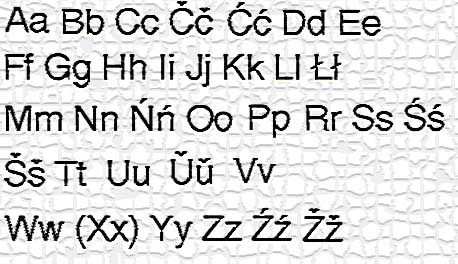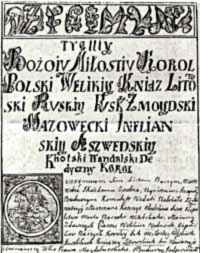|
|
|



|
Lacinka, history of usage Lacinka is the name of the Latin-script-based Belarusian writing system. Although the first known book in Latin appears within the present Belarusian borders in the beginning of the 11th century, writing in Belarus remains predominantly in the Cyrillic script until mid-16th century. Due to the domination of the Greek Orthodox church in Belarus in early Middle ages, the writing standards remained strongly influenced by the sacred Old Church Slavonic language -- the language of the Bible and liturgy in the Slavonic Greek Orthodox tradition. However, in the middle of the 16th century Belarus underwent mass Reformation, first Lutheran but later mostly Calvinist (i.e. "Presbyterian" in the North American terms), although at that point there apparently was no strict differentiation. Reformation and the Western education seem to had been among the factors which led to quite considerable "cleansing" of the official Belarusian written language from the Old Church Slavonic features by the end of the 16th century. This was the epoch when Belarusian texts written in the Latin letters appear en mass. A visitor to the National Historical Museum in Miensk may see a "Privileum of the King and Grand Duke Zygimont III Vaza" (for Poland, Sigismundus IV) to the city of Viciebsk (Vitebsk), granting it the right of self-rule according to the "Magdeburg Law". This document, dated 1597, illustrates the old-Belarusian Lacinka. (see picture on the left) This Lacinka of the 16th-17th century was in several aspects similar to the Polish writing of that age: it used "cz" for [ch] (as in 'church'), "sz" for [sh] as in 'show', "ch" for the [ch]-sound as in 'loch', and "z" with upside down "^" for [zh] (pronounced like "s" in "pleasure"). Also, similarly to the Polish of the time, it uses "y" for both "y" and for what is now "j" (e.g. "moj" (my) was spelled as "moy"), and "w" for [v] as in 'very'. However, unlike in Polish, it does not to employ the Polish "crossed L" letter (hard L), and assumes that every "L" is a firm sound: e.g. the Belarusian word for "lazy" would be spelled "lianiwy" not "laniwy." Also, the oldest Belarusian Lacinka, unlike the Polish, seem not to know the letter "g" at all, and uses only "h". For the [g] sound, for example in borrowed words, Belarusians used the "kh", such as in the King's title, where it reads as "Khotskii," whereas the Polish would spell it "Gotski". One may argue that the Belarusian Lacinka of that time was in a way a transliteration from the Cyrillic-based spelling, which could be close to the truth. Still, when the Belarusian official written language takes shape in the 17th century as something very close to what we have now, it comes to the world predominantly in its Latin script. For references, you can see, in addition to numerous documents, also the city seals of the time and the inscriptions on them. In 1654-1667 the Russian invasion wiped out Belarusian cities, and the Belarusian cultural tradition was greatly disrupted. In 1690s-1710s, the Belarusian language becomes abandoned in the official use. Still, we have the written documents in Belarusian in the 18th century, when the Uniate (Roman-Catholic of Eastern Rite, or otherwise called Greek-Catholic) Church published the religious books, such as hymnals, in Belarusian Lacinka. Some manuscripts of the drama and verse kind in Belarusian Lacinka are known from the 18th and the beginning of the 19th century. A well-known example of the Belarusian Latin-script writing is the "Muz^yckaja Prauda" ("Simple Men's Truth") newspaper, attributed to Kastus Kalinowski, which came out during the anti-Russian uprising of 1863-64. The outlook of that Lacinka is still quite Polish-like. However, in the middle and second half of the 19th century, when the "founding fathers" of the modern Belarusian literary language and literature were publishing their works, the Lacinka evolved closer to what it is now: it acquired the non-syllabic "u"-character, i.e the distinct Belarusian "u nieskladovaje" ("u" with the upside down "^"). Apart from that, the traditional "Polish-looking" letters - "z^," cz, sz, and "crossed L" were preserved, as, for example, we can see in the Krakow edition of Franciszak Bahuszewicz's "Dudka Bielaruskaja" of 1891. Naturally, "c'," "s'," "z'," "n'" (letters with a "`" on top) were used for the soft "t," "s," "z," and "n" respectively. Hence, as far as the modern Belarusian language and literature are concerned, they certainly originated in the Latin script. Printing in Belarusian was prohibited in the Russian Empire. Acording to Janka Stankievicz there was just one case, when someone published a collection of Belarusian songs in St-Petersburg, under the title of Bulgarian songs, in Lacinka, in 1890s. The liberalization of press after the 1905 Russian revolution made it possible to start Belarusian publishing. In 1907 a publishing company, called "Zahlanie slonca i w nasze wakienca" ("The Sun Will Look Into Our Window"), printed Belarusian elementary reading book, in which they reformed the Belarusian Latin script. For instance, they introduced the "c^" ("c" with upside down "^") instead of the Polish "cz", for the sound of [ch] (as in "church"), an similarly "s^" and "z^" for [sh] and [zh]. Still, they left in usage the "crossed L," as well as the "w" for [v]. As a result, their Lacinka, which soon after became the common standard, known as the "Nas^a Niva" Lacinka used less of letters in words, but more diacritics above letters. In general, it served the best to the requirements of the Belarusian pronunciation, and is used today with minor changes. In 1900s the Belarusian publishing houses started printing in the Cyrillics as well. The Cyrillic version uses (vowel) [i] as written in the Latin "i", i.e. with a dot, while the [j] (the corresponding consonant) is written as the Russian Cyrillic with "^" on top. Overall, the alphabet was a mirror image of the Old Lacinka, reverted. As the Old-Belarusian Lacinka was initially a transliteration from the Old-Belarusian Cyrillics, the modern-Belarusian Cyrillics remains nothing but, essentially, a transliteration from the modern-Belarusian Lacinka script, and preserves all the Lactinka features up untill this day. This point is obvious from the comparison of the two systems of the (modern) Belarusian writing, with regard to two consonants - "d" and "t," which, when soft, are treated differently from other comsonants in the Belarusian Lacinka -- and as result in the Belarusian system of Cyrillic writing ("d'" become "dz" and "t" becomes "c"). Finally, the modern Belarusian Cyrillics picked up Bahuszewicz's Lacinka "u^" and adopted a Cyrillic mirror-image of it, which hence became a distinct feature of the Belarusian Cyrillic writing. "U nieskladovaje" does not exist in any other language's writing system. In the 1910s the two systems coexisted. Half of the books' circulation was printed in Lacinka, and the other in Cyrillics. For example, "Nas^a Niva" newspaper was published both in Lacinka and Cyrillics. Nevertheless, it appears that the Latin-script tradition was regarded, in a sense, as more legitimate of the two. For example, when in 1915, upon Vilnia's occupation, Paul von Hindenburg recognized, on behalf of Seine Majestät's Wehrmacht, the official status of the Belarusian language in its Lacinka version. (So, if we ever build a monument to Fieldmarschal von Hindenburg in Belarus in a gesture of gratitude, it will be a must that we inscribe his name there in Latin letters). In the part of Belarus that belonged to the USSR after 1921, the Lacinka was, apparently, never used, at least officially. Although, the issue which system to use was debated in the press till 1926. That did not go on for long, as Stalin's repressions began and Belarusian intellectual elite was virtually eliminated. Menawhile, in the Western part of Belarus belonging to Poland, the two scripts continued to coexist. Although, resisting the Polonization policies under Pilsudski, Belarusians seemed to begin giving priority to the Cyrillic script. In the late 1930s some publishers, apparently struggling against the much-hated at that time "Polish features", began to abandon the historical "w" for the "v" (the [v]-sound like "very"). The process was completed during the World War II, when in the Elementary Grammar Books for the Belarusian schools printed in 1943 the "w" was not in use anymore. From the early 1940s until the Belarusian Revival of the late 1980s-early 1990s, the Lacinka printing continued, but only in emigration. As Belarus became independent, some efforts have been made to revive the original script of the modern Belarusian literary language. Examples of such publications are "Nas^a Niva" newspaper revived in 1993, several issues of the "Chryscijanskaja Dumka" ("Christian Thought") journal, reprints from 1930s editions, and most recently the issues of the "Spadc^yna" ("Heritage") magazine.Among young Belarusian intellectuals, writing in Lacinka is gradually becoming a matter of good taste. Although, there have been several public calls to simplify it. For example, there is a considerably active group which insists on replacing the "u^" ("u"-consonant), i.e. with the character of "w," which has otherwise remained "unemployed" since WW2. Others have proposed that the "crossed L" is to be abolished, for the sake of simplicity and uniformity in denoting the softness of consonants. For example, during the Founding Congress of the BPF Youth's "Young Front" organization in September 1997 there was a proposal to adopt the Lacinka as the only official script used in the organization's documents, but this proposal was put aside because of, inter alia, disagreements on how modern Lacinka should look like. The disagreements will disappear after sufficient amount of texts is published in certain Lacinka version, which will effectively revive Lacinka to some wider public use, and thus establish a standard by the virtue of practice. Meanwhile, the "classic" (Nas^a Niva/Taras^kievic^) version is best to use to stay "correct." Undoubtedly, the revival of Lacinka and its official recognition will assist in increasing the degree of accessability to information and also make it easier for Belarusians to learn foreign languages. Furthermore, it will reinforce Belarus' Central European indentity. I'd like to believe that there can be some brighter future for the Belarusian Lacinka. As a precondition, meanwhile, there is a need to insure some brighter prospect for Belarus itself. You can read the complete version on Mikola Paczakajew's Cambridge University web-site: http://www.cus.cam.ac.uk/~np214/lacin.htm
|